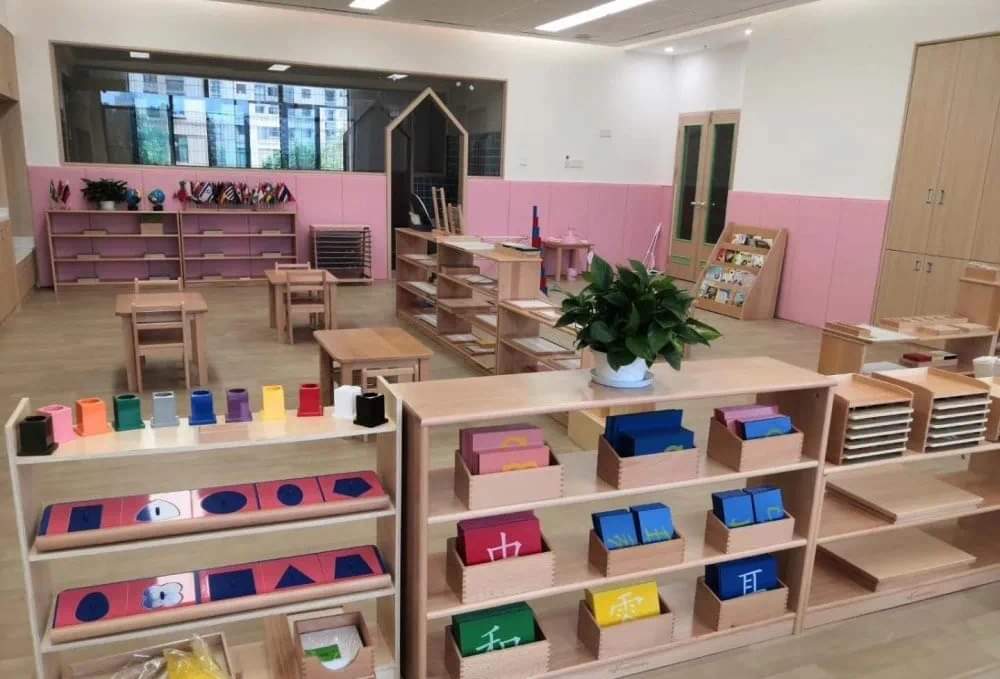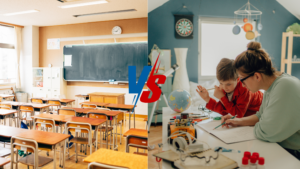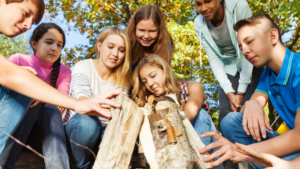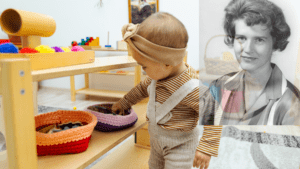Montessori education is based on the idea that children have an innate desire to learn and a natural ability to do so.
The prepared environment is often referred to as The Montessori Environment or Montessori prepared environment. The Montessori environment in Montessori schools is a space that is set up to create an environment that stimulates the senses and provides a variety of materials for the children to explore. This not only helps them develop their cognitive skills but also has many other benefits, like developing their language skills and social skills. It is prepared and setup based on the Montessori philosophy that every child should be raised in an environment that allows them to experience and learn from sensory stimulation.
The light and easily moved tables, chairs, and armchairs permit a child to choose the most convenient position. He can make himself comfortable rather than sit in one place, and this is at once an indication of his inner freedom and a further means of education. If a child’s awkward movements make a chair fall over with a crash, he has an obvious proof of his own incapacity. A similar movement among desks would have passed unnoticed. A child thus has a means of correcting himself, and when he has done so he has proof positive of it: the chairs wand tables remain silent and unmoved where they are. When this has happened, one can say that the child has leaned how to move about. – Dr. Maria Montessori, The discovery of the child, p 50.
Setting up a Montessori classroom includes:-
-
Selecting classroom furniture
-
Building a “found materials” area
-
Choosing books and literacy activities,
-
Placing live plants. and
-
Selecting other sensory items, such as sand and water.
Children are typically exposed to a broad range of sensory experiences that encourage exploration through the five senses. Mixed-age classrooms allow for a variety of ages within the same classroom environment. It also allows children to learn from each other. The Montessori approach includes learning through observation and discovery, which is an opportunity for children to learn more effectively.
What does a Montessori Classroom Look Like?
The spatial layout of the classroom is not highly structured because students should be able to choose where they sit based on their interests and personality. It has a large arc where children will gather for learning activities such as art, reading, science, and music. The walls are painted in soft, pastel colors. The room has large windows to provide natural light and glass cabinets for storing art supplies and materials.
The room is further divided into four areas: a well-equipped kitchen area, which includes a sink, refrigerator, and countertops; an outdoor area with a covered porch; two large group activities that are divided by age group; and a play space for children to occupy themselves. There are windows that provide ample natural light and a large sliding door with an awning. The classroom includes indoor, outdoor, and play spaces, each of which supports the different needs of learners.
In the Montessori classroom, a balance should be given to learning through both “sensorial” and “intellectual” means of information delivery. Sensory learners learn from the five senses: sight, hearing, touch, taste, smell, and kinesthetic. Intellectually minded learners learn through the mind and make connections to their own world.
Let us take an example:
To introduce practical life lessons, the shelf in a Montessori class will include materials for activities, such as:
-
Transferring beans from one bowl to another
-
Pouring water from a jar into a glass
-
Nuts and bolts
-
Sorting different food items using tongs
-
Beads sorting through pliers
-
Sewing with needles
-
How to dress using dressing frames
-
Beading
-
Cutting fruits
-
Juicing oranges
There are endless activities that can be added to the practical life classroom. The setup of the class is in such a way that the child has the freedom to pick any material and learn from it. Creating the aura, arranging various activity materials on the shelves, and providing them space to experiment is called Montessori prepared environment. I hope you got a fair idea about it now. Let us understand its benefits now.
Benefits of the Prepared Environment in Montessori
Since the Montessori method is based on the observation that children learn through their own self-directed activity, rather than being taught, will reach higher levels of cognitive development.
A prepared environment is an environment that has been set up in a way that will facilitate learning. This means that all materials needed for a certain task are already present in the environment and ready for use.
The benefits of Montessori-prepared environments include:
-
Increased independence,
-
Increased focus,
-
Enhanced creativity, and
-
Improved problem-solving skills.
The Montessori school environment does not include any distractions like a lot of other schools. The students do not get pulled into other activities, which helps them concentrate on their work. Montessori classrooms are designed to promote and enhance the natural intelligence of each individual student. There is no focus on competition or grades, and the students are encouraged to work cooperatively with their peers. It has a long list of benefits for both adults and children.
An example of a prepared environment is the classroom at an elementary school. Montessori guides spend time planning on how to meet the needs of all students in the room. They create different assignments, focus on different areas, and have tangible materials such as pictures and charts for students to look at when they don’t know what to do next. Meeting the needs of all students in the classroom can lead to improved learning. Students with more focused attention have greater success in the classroom and have more opportunities to take ownership of their learning. Also, students who feel more prepared can ask questions and actively take part in class discussions that they otherwise could not do.
The benefits of such a prepared environment extend far beyond the classroom, as students who focus tend to feel better prepared for their lives after school. A Montessori guide ensures that the classrooms are engaging and effective spaces by providing opportunities for child-led interactions. These opportunities are frequent, diverse, and strategically placed in the day.
Why There is a Fuss about Montessori’s Prepared Environment?
The prepared environment is an important element of Montessori education as it provides children with a variety of materials, tools, and activities in advance for them to explore as they wish. It also provides a place for children to engage in activities that are part of the curriculum and to take care of materials such as cleaning up. Thus, making it very important for any classroom.




